Ensure that File and Printer Sharing Is Enabled
Although Windows automatically installs and enables the protocol for file and printer sharing, it can be accidentally disabled. Thus you should double-check it, especially if you're currently having sharing problems.
On the network connection's properties dialog (see Figure 1) you want to make sure the File and Printer Sharing for Microsoft Networks and Client for Microsoft Networks protocols are enabled.
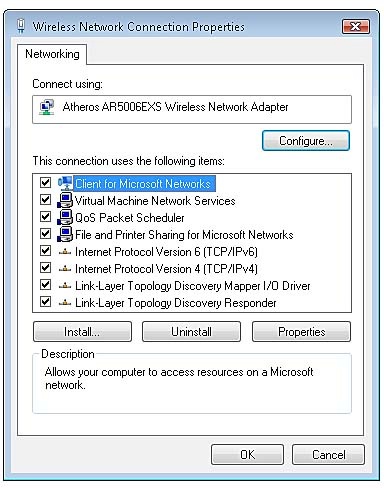
Figure 1
To get to the Properties dialog of a network connection in XP, click Start > Connect to> Show all connections. Then right-click the network connection you're using and select Properties.
Here's how to get there in Vista: open the Network and Sharing Center and click the Manage network connections link on the left pane. Then right-click the network connection and select Properties.
In Windows 7, open the Network and Sharing Center, click the desired connection name link in the active networks area. On the connection status windows, click the Properties button.
Disable the Simple or Wizard File-Sharing Interface
Windows XP Professional and all editions of Vista and Windows 7 have advanced sharing settings. When you use the advanced method, you can better control sharing using Permissions.
You'll be using a similar approach among your computers, regardless of their Windows version.
Here's how to disable the simple or wizard-based sharing interface:
Open Computer or My Computer.
Click Tools and select Folder Options.
If you don't see the file menu in Vista or Windows 7, press the Alt key.
Click the View tab.
Scroll down and uncheck Use Sharing Wizard (in Vista or Windows 7) or Use Simple File Sharing (in XP).
Click OK to save the changes.
Verify that Everyone Is on the Same Workgroup
On home and small business networks, computers must be assigned to a Workgroup. You should have all the computers that you want to share with each other set to the same group.
Because some Windows versions have different default workgroup names, you should decide on a particular name and verify that each computer is set to the same.
To find the current Workgroup of a Windows XP, Vista, or Windows 7 machine, right-click the My Computer or Computer shortcut from the desktop or start menu and select Properties. You'll see the computer name, domain, and workgroup setting on the System window.
While you're at it, you can also verify that you have descriptive computer names, so you can tell which PC is which when you browse the network.
Check the Network Location in Vista and Windows 7
A network location feature, which debuted in Windows Vista, lets you specify the network type (Home, Work, and Public) after connecting, which automatically applies the appropriate sharing settings.
For example, if you connect to a Wi-Fi hotspot and mark it as a Public network, Windows will automatically disable file sharing.
To verify that you have the right network location selected for your network, bring up the Network and Sharing Center.
Windows Vista lists this to the right of the network name, as Figure 2 shows.
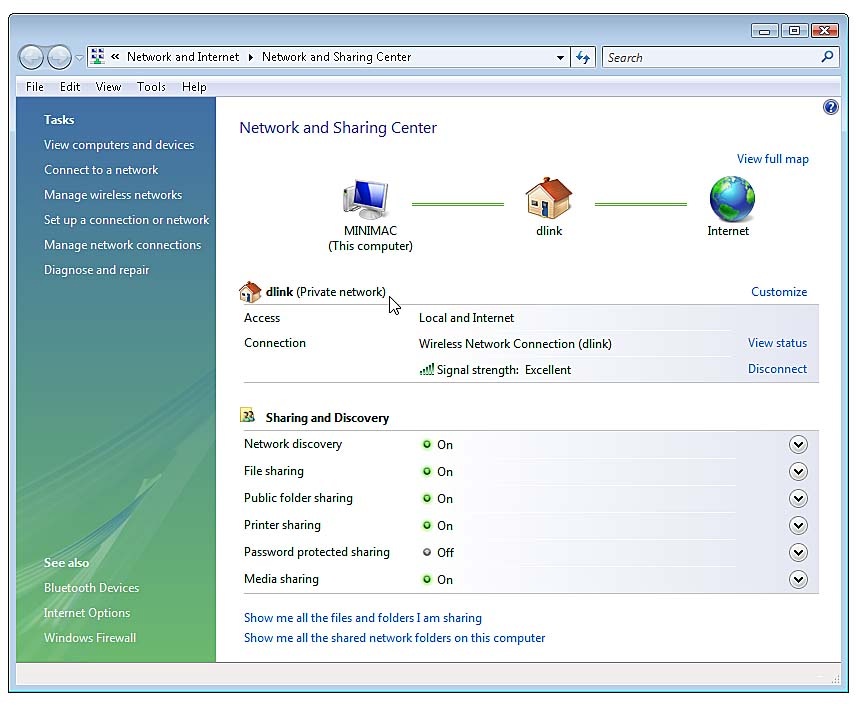
Figure 2
If you need to change it, click the Customize link on the right side.
In Windows 7, the location is listed under the network name, as Figure 3 shows.
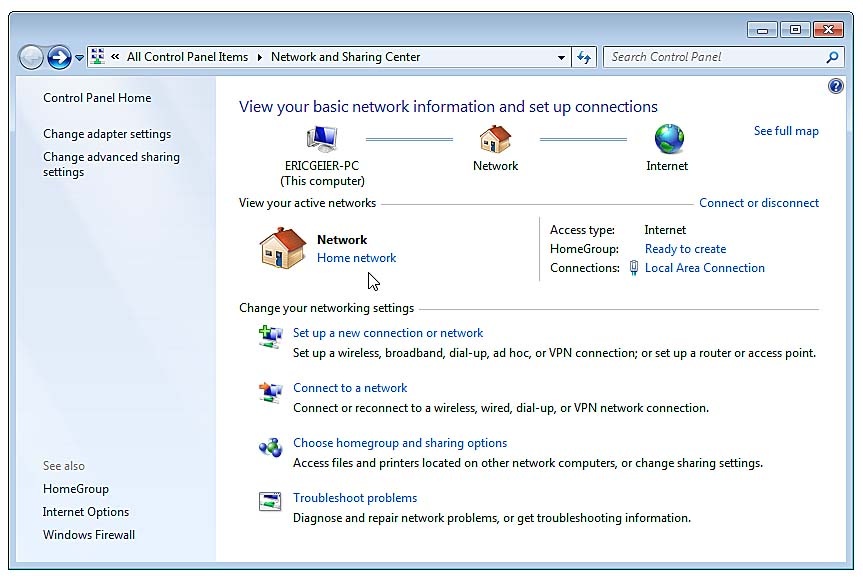
Figure 3
Then simply click the location to change it.
Review the Network Settings in Vista and Windows 7
Microsoft also added more networking and sharing settings to Windows, starting with Vista. If they aren't set right, they could prevent you from sharing; so you need to double-check them.
Start by bringing up the Network and Sharing Center.
In Vista, you'll see the Sharing and Discovery settings right under the connection details, as Figure 4 shows.
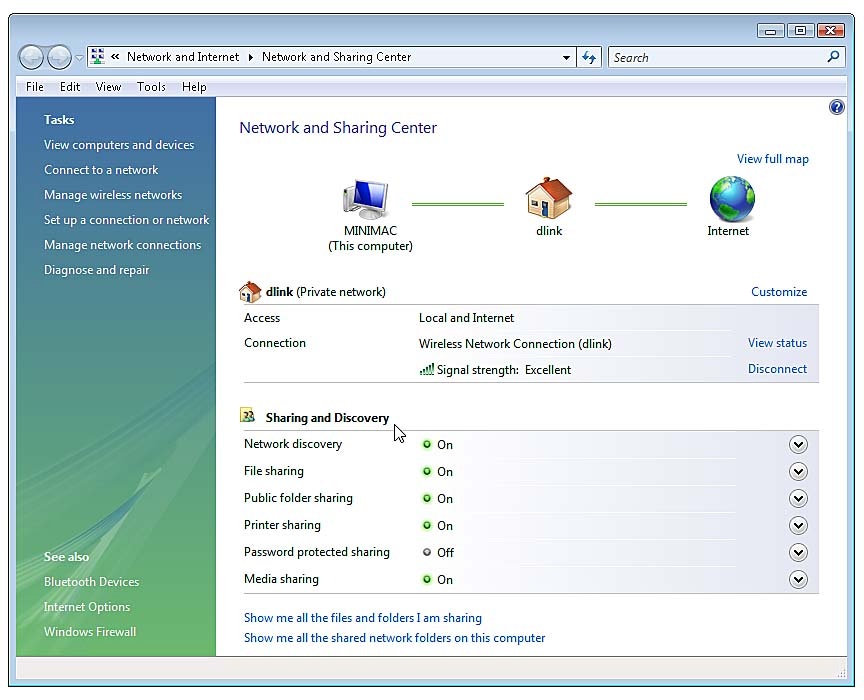
Figure 4
If you want to sharing files, make sure at least the first options are enabled.
In Windows 7, these settings have moved. On the Network and Sharing Center, click the Change advanced sharing settings link in the left pane.
Then for the Home or Work location (see Figure 5), make sure you at least have the first two options enabled.

Figure 5
Verify that Your Firewall Lets Traffic Through
Windows automatically edits the Windows Firewall settings to allow file and printer sharing traffic through when you enable sharing.
However, you can manually disable the firewall rule or stop all network traffic, both of which would prevent your computers from communicating. So you should double-check the settings.
In Windows XP, open Windows Firewall from the Control Panel. On the Windows Firewall dialog, make sure it's On, but do not check the Don't allow exceptions option.
Click the Exceptions tab, scroll down, find the File and Printer Sharing option, and make sure it's checked.
In Windows 7 and Vista, first open the Network and Sharing Center and click the Windows Firewall link on the bottom of the left pane.
Then in Vista, click the Change settings link on the first Windows Firewall window. On the settings dialog, make sure it's On, but do not check the Block all incoming connections option.
Click the Exceptions tab, scroll down, find the File and Printer Sharing option, and make sure it's checked.
In Windows 7, first click the Turn Windows Firewall on or off link to make sure it's on but not blocking all incoming connections, as Figure 6 shows.
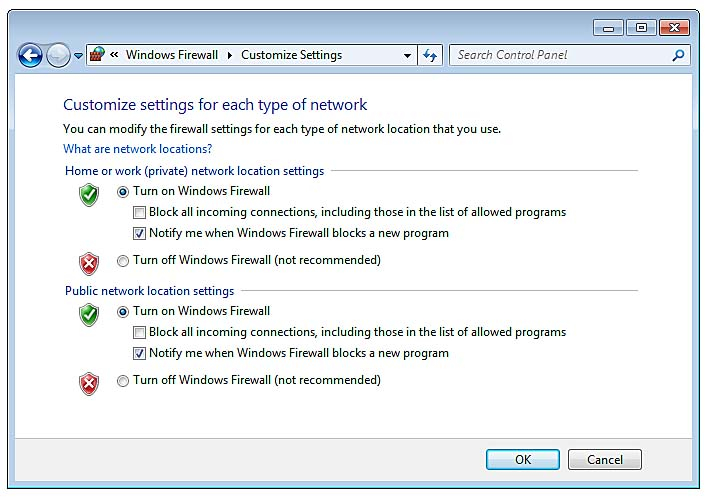
Figure 6
Return to the first Windows Firewall window and click the Allow a program or feature through Windows Firewall link in the upper left of the window.
Make sure that the File and Printer Sharing option is checked for Home/Work locations.
If you also have a third-party firewall utility installed, which may be a part of an Internet security suite, check that one, too. Sometimes they have their networking protect features. For example, some require you to mark the network as safe in order for sharing to work.






























 Recent Blue Posts
Recent Blue Posts
 Recent Forum Posts
Recent Forum Posts
 Season 4... Just old dungeons and new ilvl?
Season 4... Just old dungeons and new ilvl? [WeakAura] Tombstone's Conditions
[WeakAura] Tombstone's Conditions Did Blizzard just hotfix an ilvl requirement onto Awakened LFR?
Did Blizzard just hotfix an ilvl requirement onto Awakened LFR? MMO-Champion
MMO-Champion


 Reply With Quote
Reply With Quote



